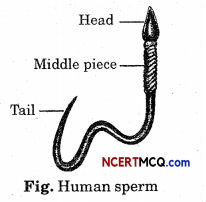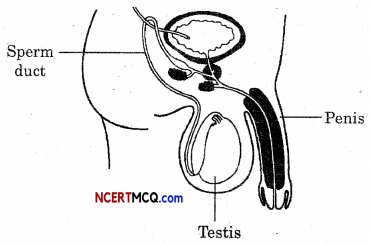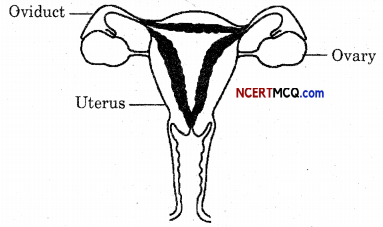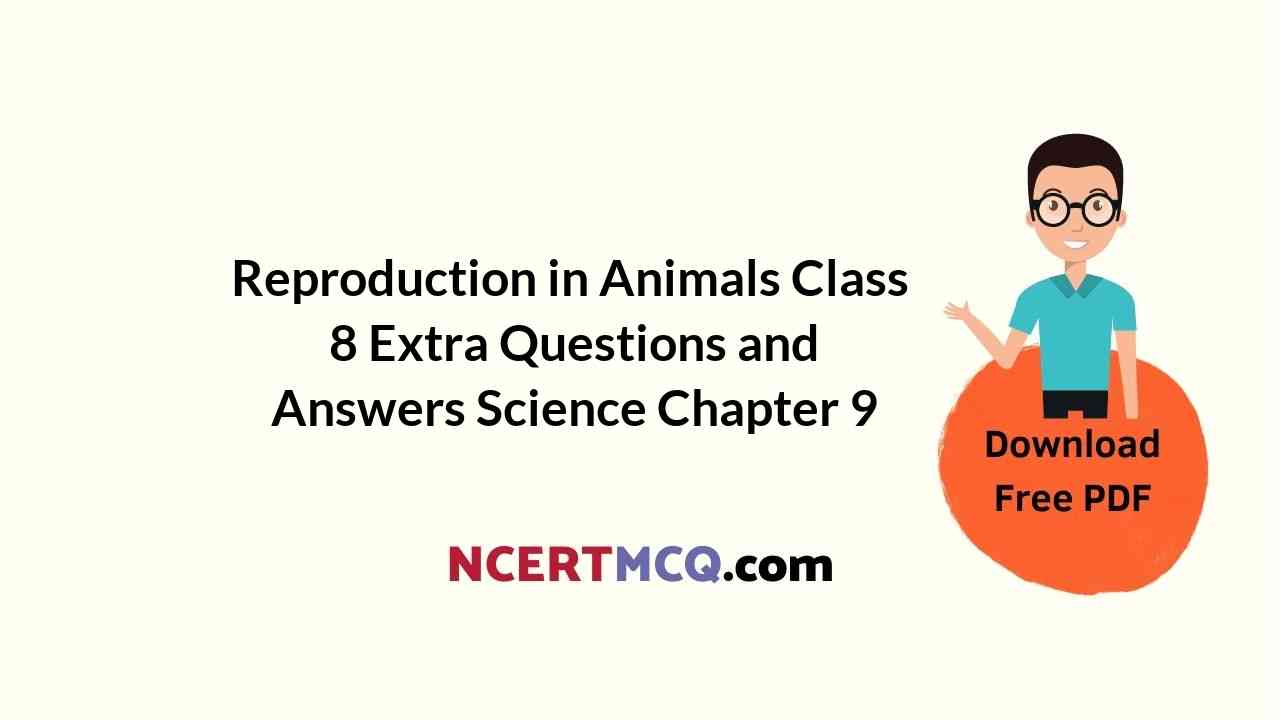Here we are providing Online Education Reproduction in Animals Class 8 Extra Questions and Answers Science Chapter 9 was designed by subject expert teachers. https://ncertmcq.com/extra-questions-for-class-8-science/
Online Education for Class 8 Science Chapter 9 Extra Questions and Answers Reproduction in Animals
Reproduction In Animals Class 8 Questions And Answers Question 1.
Indicate whether the following statement is true or false: A zygote is formed as a result of fertilization.
Answer:
True.
Reproduction In Animals Questions And Answers Question 2.
Indicate whether the following statement is true or false: An embryo is made of a single cell.
Answer:
False.
Ncert Science Book Class 8 Extra Questions With Answers Question 3.
Indicate whether the following statement is true or false: Fertilization is necessary even in asexual reproduction.
Answer:
False.
Extra Question Of Class 8 Science Question 4.
What is the name of reproduction in which fusion of male and female gametes takes place?
Answer:
It is called as sexual reproduction.
![]()
Reproduction In Animals Question Answers Question 5.
What does tests produce?
Answer:
The testes produce the male gametes called sperms.
Reproduction In Animals Class 10 Questions And Answers Question 6.
What name is given to the babies born through in vitro fertilisation technique?
Answer:
Test-tube baby.
Reproduction In Animals Class 8 Question 7.
Draw the figure of a sperm.
Answer:

Reproduction In Animals Class 8 Question Answers Question 8.
What happens when sperms come in contact with the egg?
Answer:
Fertilisation takes place.
Extra Questions For Class 8 Science With Answers Question 9.
What is the other name of a fertilised egg?
Answer:
Zygote.
Class 8 Science Extra Questions Question 10.
What is meant by in vitro fertilisation?
Answer:
It means that fertilisation is done outside the body through artificial means.
![]()
Extra Questions Class 8 Science Question 11.
What is the fertilisation called which takes place inside the female body?
Answer:
It is called internal fertilisation.
Extra Questions Of Science Class 8 Question 12.
Which organisms undergo internal fertilisation?
Answer:
Humans, cows, goats, dogs, horses, elephants, buffaloes, etc.
Extra Questions For Class 8 Science Question 13.
Where does the external fertilisation take place?
Answer:
It takes place in water.
Class 8 Science Ncert Extra Questions Question 14.
What happens after fertilisation?
Answer:
The fertilisation results in the formation of zygote, which begins to develop into an embryo.
Extra Questions Of Class 8 Science Question 15.
When does a mother give birth to young one?
Answer:
When the development of the foetus is complete, the mother gives birth to young one.
Question 16.
What name is given to animals which give birth to young ones?
Answer:
They are called viviparous animals.
![]()
Question 17.
What name is given to the animals which lay eggs?
Answer:
They are called oviparous animals.
Question 18.
Do the young ones in all animals look alike?
Answer:
No, in some animals, the young ones may look very different whereas in other animals the young ones look alike.
Question 19.
Give the different stages in frog’s life-cycle.
Answer:
It is as follows: Egg → tadpole (larva) → adult.
Question 20.
State the stages of life cycle of silkworm.
Answer:
It is as follows: Egg → larva or caterpillar → pupa (cocoon) → adult (moth).
Question 21.
What name is given to the drastic change that takes place during the development of an animal?
Answer:
Metamorphosis.
Question 22.
State the reproduction in which new individual develops from the buds in Hydra.
Answer:
Budding.
Question 23.
What is the name of the process of reproduction in Amoeba?
Answer:
Binary fission.
![]()
Question 24.
What name is given to a process in which production of an identical cell or a complete organism is done?
Answer:
Cloning.
Question 25.
Who performed the cloning process for the first time and where?
Answer:
Ian Wilmut and his colleagues at Roslin Institute in Edinburgh, Scotland.
Question 26.
What is the name of the sheep which was closed for the first time in the world?
Answer:
Dolly.
Question 27.
When was Dolly bom? When and how she died?
Answer:
It was born on 5th July 1996 and it died on 14th February 2003 due to a certain lung disease.
Question 28.
Define internal fertilization with: two examples.
Answer:
Fertilization which takes place inside the female body is called internal fertilization. Examples: Humans, cows, etc.
![]()
Question 29.
Define oviparous animals with two examples.
Answer:
The animals which lay eggs are called oviparous animals. We haye seen the eggs of the birds. These animals lay eggs and then the chicks hatch out of the eggs. The examples of oviparous are hen, peacock, crow and parrot, etc.
Question 30.
What is uterus? Is egg a single cell?
Answer:
Uterus is the part where development of the baby takes place. Yes, an egg is a single cell.
Question 31.
What happens when oviducts of women are blocked?
Answer:
In some women oviducts are blocked. These women are unable to bear babies, because’ sperm cannot reach the egg for fertilisation.
Question 32.
Are test-tube babies born in test- tubes?
Answer:
No. Only fertilisation is done in test tubes and then the zygote is placed in the mother’s uterus.
Question 33.
Define foetus.
Answer:
The stage of the embryo in which all the body parts are identifiable is called foetus.
![]()
Question 34.
How long does embryo take to develop into chick?
Answer:
The embryo takes three weeks to develop into a chick. During this period hen sits on the eggs to provide sufficient warmth.
Question 35.
Do tadpoles look different from the adult?
Answer:
Yes, tadpoles look very different from the adult frog. In a few days, the tadpoles become frogs after complete metamorphosis.
Question 36.
Do human beings also undergo metamorphosis?
Answer:
In human beings, body parts of the young ones similar to the adults are present from the time of birth. So, human beings do not undergo metamorphosis.
Question 37.
Give examples of organisms undergoing asexual reproduction. Name the type of asexual reproduction in them.
Answer:
The organisms undergoing asexual reproduction are
- Hydra, and
- Amoeba.
The process of reproduction in Hydra is called budding and in Amoeba is known as binary fission.
Question 38.
Write a short note on sperms.
Answer:
Sperms are the male gametes produced by testes. Millions of sperms are produced by the testes. Though the sperms are very small in size, each has a head, a middle piece and a tail. Each sperm is a single cell having all the usual cell components. The tail present in the sperm enables it to swim in the oviduct to reach the egg and perform fertilisation process.
Question 39.
Describe briefly the female reproductive organs.
Answer:
The female reproductive organs are a pair of ovaries, oviducts (fallopian tubes) and the uterus. The ovary produces female gametes called ova (eggs). The egg so produced is a single cell.
In human beings, a single matured egg is released into the oviduct by one of the ovaries every month. Uterus is the part where development of the baby takes place.
![]()
Question 40.
How does fertilisation take place and how is zygote formed? Is zygote the beginning of a new individual?
Answer:
When the sperms come in contact with the egg, one of the sperms may fuse with the egg. The fusion of the egg and the sperm is known as fertilisation, which produces zygote.
The process of fertilisation is the meeting of an egg cell from the mother and a sperm cell from the father. So, the new individual inherits some characters from the mother and some from the father and, therefore, zygote is the beginning of a new individual.
Question 41.
Describe in vitro fertilisation and production of test-tube babies.
Answer:
When some women are unable to bear babies because of blocked oviducts. In doctors collect freshly released egg and sperms and keep them together for a few hours for in vitro fertilisation (fertilisation in test-tube).
After the zygote develops for about a week, it is placed in the mother’s uterus. Complete development takes place in the uterus and the baby is born like any other baby.
Question 42.
Raju has a friend who believes that mother is responsible for the sex of a child because she gives birth to the child.
(a) How will Raju correct him using his knowledge of human chromosomes?
(b) What are the values shown by Raju?
Answer:
(a) No, Raju’s friend has wrong perception as mother is not responsible for the gender of the baby.
The sex of baby is depends upon the chromosome. In human beings, 23rd pair are sex chromosomes named X and Y. All unfertilized egg have one X chromosome. But sperms carry different chromosomes X as well as Y.
If a sperm containing X chromosome fertilizes the egg then the resulting fertilized egg contains two X chromosomes that will give birth to a baby girl whereas if a sperm containing Y chromosome fertilizes the egg then the resulting egg contains one X and one Y chromosome that gives birth to a baby boy.
(b) The value shown by Raju is ‘awareness’.
![]()
Question 43.
Describe the process of fertilisation in humans?
Answer:
In humans, the process of fertilisation is internal. For this millions of sperms from the male are transferred into the female body. The sperms swim in the oviduct with the help of their tails to reach the egg, when they come in contact with the egg, one of the sperms may fuse with the egg and fertilisation is completed. During fertilisation, the nuclei of the sperm and the egg fuse to form a single nucleus and zygote is formed. Fertilisation makes the new individual inherits some characteristics from the mother and some from the father.
Question 44.
Draw a labelled diagram of male reproductive organ of human.
Answer:

Question 45.
Draw a labelled diagram of female reproductive organ of human.
Answer:

Question 46.
Name two animals which undergo metamorphosis. Also, name the stages they pass by ? Draw a diagram of different stages of anyone animal.
Answer:
Two animals that undergo metamorphosis are :
(i) Frog.
(ii) Silkworm.

Different stages of frog’s life-cycle :
Egg→ Tadpole (larva) → Frog (adult). Different stages of silkworm’s life-cycle: Egg → Caterpillar → Cocoon (pupa) → Moth (adult).
Multiple Choice Questions (MCQs)
1. External fertilization is common
(a) Terrestrial animal
(b) Aquatic animal
(c) None of these.
Answer:
(b) Aquatic animal.
![]()
2. A tadpole develops into an adult frog by the process of
(a) Fertilization
(b) Metamorphosis
(c) Embedding
(d) Budding.
Answer:
(b) Metamorphosis.
